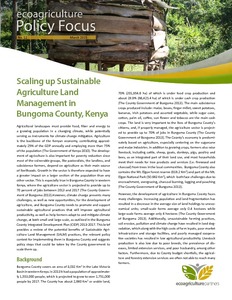Resource information
Agricultural landscapes must provide food, fiber and energy to
a growing population in a changing climate, while potentially
serving as instruments for climate change mitigation. Agriculture
is the backbone of the Kenyan economy, contributing approximately
25% of the GDP annually and employing more than 75%
of the population (The Government of Kenya 2010). The development
of agriculture is also important for poverty reduction since
most of the vulnerable groups, like pastoralists, the landless, and
subsistence farmers, depend on agriculture as their main source
of livelihoods. Growth in the sector is therefore expected to have
a greater impact on a larger section of the population than any
other sector. This is especially true in Bungoma County in western
Kenya, where the agriculture sector is projected to provide up to
70 percent of jobs between 2013 and 2017 (The County Government
of Bungoma 2013).However, climate change presents many
challenges, as well as new opportunities, for the development of
agriculture, and Bungoma County needs to promote and support
sustainable agricultural practices that will improve agricultural
productivity, as well as help farmers adapt to and mitigate climate
change, at both small and large scale, as outlined in the Bungoma
County Integrated Development Plan (CIDP) 2013-2017. This brief
provides a review of the potential benefits of Sustainable Agriculture
Land Management (SALM) practices, the relevant policy
context for implementing them in Bungoma County and suggests
policy steps that could be taken by the County government to
scale them up.


